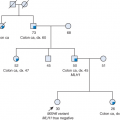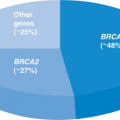Genetic Testing by Cancer Site: Uterus
Molly S. Daniels
Uterine cancer is the most common invasive gynecologic cancer in the United States.1 The median age at diagnosis of uterine cancer in the general population is 60 years.1 The average woman’s lifetime risk of developing uterine cancer is approximately 2.6%.2 The vast majority of uterine cancers are endometrial in origin. Five percent or less of uterine cancers are nonendometrial; examples include endometrial stromal sarcoma and uterine leiomyosarcoma.3
Endometrial cancers can be further subdivided into type I and type II. Type I endometrial cancers are endometrioid in histology and account for more than 75% of endometrial cancers. Type II endometrial cancers include all nonendometrioid histologies, such as uterine papillary serous carcinoma (UPSC), clear cell carcinoma, and carcinosarcoma (also called malignant mixed Müllerian tumor).4 Type II endometrial cancers are generally diagnosed at later stages and have a poorer prognosis than type I endometrial cancers.5
Type I endometrial cancers, in particular, are associated with personal medical history risk factors, likely due to their impact on the amount of estrogen to which the endometrium is exposed. Other than long-term use of unopposed estrogen (which is no longer prescribed for women with an intact uterus because of the associated endometrial cancer risk) and hereditary cancer predisposition (which will be discussed below), the biggest risk factor for endometrial cancer is obesity. Obese women have up to a sixfold risk of endometrial cancer when compared with women at ideal body weight.6 Other risk factors include nulliparity, early age at menarche, late age at menopause, and tamoxifen use.6 Use of combination oral contraceptives decreases risk of endometrial cancer in the general population, with a relative risk of 0.6.1
This review also discusses uterine leiomyomas, commonly referred to as uterine fibroids. Uterine leiomyomas are benign smooth muscle tumors that are common in the general population. A US study found that more than 80% of black women and almost 70% of white women develop uterine leiomyomas, although not all were symptomatic.7 Symptoms of uterine leiomyomas can include pelvic pain, infertility, pregnancy complications, and menometrorrhagia.7
Lynch Syndrome, also Known as Hereditary Nonpolyposis Colorectal Cancer Syndrome
Since Lynch syndrome has been extensively described elsewhere in this book, this section focuses on Lynch syndrome–associated endometrial cancer. Lynch syndrome is an autosomal dominant hereditary cancer predisposition syndrome characterized by significantly increased risks of colorectal, endometrial, and other cancers. Mutations in the DNA mismatch repair genes MLH1, MSH2, MSH6, PMS2, and EPCAM (via disruption of MSH2 expression) have been associated with Lynch syndrome.
Two to three percent of women with endometrial cancer have Lynch syndrome.8,9 Average age at diagnosis of endometrial cancer for women with Lynch syndrome is in the 40s to 50s in many8,9,10 (but not all11) studies, younger than the general population. The likelihood of Lynch syndrome is increased in women with endometrial cancer; diagnosed at younger than 50 years,12,13 who have also had colorectal cancer,14 with lower body mass index,12 with lower uterine segment tumors,15 or with family history of colorectal and/or endometrial cancers.16,17 Models to assess risk of Lynch syndrome based on personal and family history are available.16,17 The identification of Lynch syndrome in the endometrial cancer patient allows her to take steps to reduce her colorectal cancer risk and also allows family members to benefit from predictive genetic testing and subsequent targeted cancer risk reduction strategies.
The optimal way to screen endometrial cancer patients for Lynch syndrome is an area of active discussion. Historically, endometrial cancer patients with personal and/or family histories suggestive of Lynch syndrome have been referred for cancer genetic risk assessment. More recently, some institutions have undertaken universal screening of all endometrial cancer patients by immunohistochemistry (IHC) and/or microsatellite instability (MSI) analysis of the endometrial tumor.18 The advantage to this approach is that it has the potential to detect all Lynch syndrome–associated endometrial cancers, some of which occur in the absence of a known family history and would be missed by any strategy that screens patients by family history.8,9 Limitations to the universal screening approach include high cost per mutation identified19 and lower than expected uptake of genetic counseling and genetic testing among endometrial cancer patients identified via universal screening.18
By whatever method endometrial cancer patients are selected for Lynch syndrome evaluation, the recommended first step in genetic testing is tumor studies: IHC for the mismatch repair proteins and/or MSI analysis.20,21 Nearly all Lynch syndrome–associated endometrial cancers will demonstrate high MSI (MSI-H) and/or IHC loss of one or more mismatch repair proteins, and the IHC results often allow genetic testing to be targeted to one Lynch syndrome gene.20 MLH1 promoter hypermethylation analysis is recommended as a follow-up study when an endometrial tumor is MSI-H, and IHC shows loss of MLH1 and PMS2, because 15% to 20% of sporadic endometrial cancers exhibit MLH1 promoter hypermethylation.22 Whereas sporadic MSI-H colorectal cancers often have somatic BRAF mutations, sporadic MSI-H endometrial cancers usually do not,23 and therefore, BRAF mutation analysis is not
recommended for distinguishing sporadic MSI-H endometrial cancers from Lynch syndrome–associated endometrial cancers. Lynch syndrome is confirmed by the finding of a germline mutation in a mismatch repair gene through molecular genetic testing, and family members can subsequently undergo predictive genetic testing. Currently, molecular genetic testing is not always able to identify a pathogenic Lynch syndrome mutation when tumor studies are suggestive of Lynch syndrome; possible explanations in these cases include limited genetic test sensitivity for the known mismatch repair genes, other as yet unidentified Lynch syndrome genes, and as yet unidentified other epigenetic causes for the tumor phenotype. Given that Lynch syndrome has not been ruled out in a patient with suggestive tumor studies and negative genetic test results, consideration should be given to following Lynch syndrome management guidelines in these cases.20,21
recommended for distinguishing sporadic MSI-H endometrial cancers from Lynch syndrome–associated endometrial cancers. Lynch syndrome is confirmed by the finding of a germline mutation in a mismatch repair gene through molecular genetic testing, and family members can subsequently undergo predictive genetic testing. Currently, molecular genetic testing is not always able to identify a pathogenic Lynch syndrome mutation when tumor studies are suggestive of Lynch syndrome; possible explanations in these cases include limited genetic test sensitivity for the known mismatch repair genes, other as yet unidentified Lynch syndrome genes, and as yet unidentified other epigenetic causes for the tumor phenotype. Given that Lynch syndrome has not been ruled out in a patient with suggestive tumor studies and negative genetic test results, consideration should be given to following Lynch syndrome management guidelines in these cases.20,21
The lifetime risk of endometrial cancer for women with Lynch syndrome has been recently reported as 33% to 40%.10,24 Endometrial cancer risk may vary by gene, with risks highest for women with MLH1, MSH2, and MSH6 mutations. Lower endometrial cancer risks have been reported for women with PMS2 mutations (15% lifetime risk25) or EPCAM mutations (up to 12% lifetime risk26,27). Lynch syndrome–associated endometrial cancers can be both type I (endometrioid) and type II (nonendometrioid); nonendometrioid histologies observed in women with Lynch syndrome include clear cell carcinoma, UPSC, and malignant mixed Müllerian tumor (carcinosarcoma).28
Given the high risk of endometrial cancer for women with Lynch syndrome, both cancer screening and risk reduction options should be considered. Patient education regarding endometrial cancer symptoms (such as abnormal vaginal bleeding) and the importance of reporting them promptly are also important.21 In terms of risk reduction, hysterectomy (plus bilateral salpingo-oophorectomy [BSO], because ovarian cancer risk is also elevated) is clearly effective in preventing endometrial cancer29 and can be considered if childbearing is completed and/or after menopause.21,30,31




Stay updated, free articles. Join our Telegram channel

Full access? Get Clinical Tree





